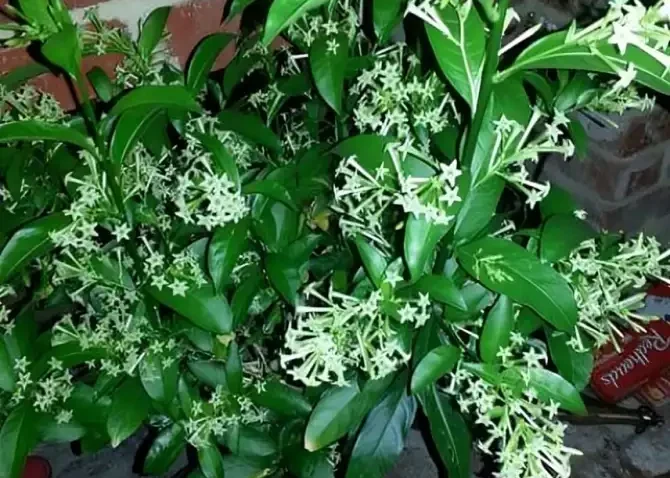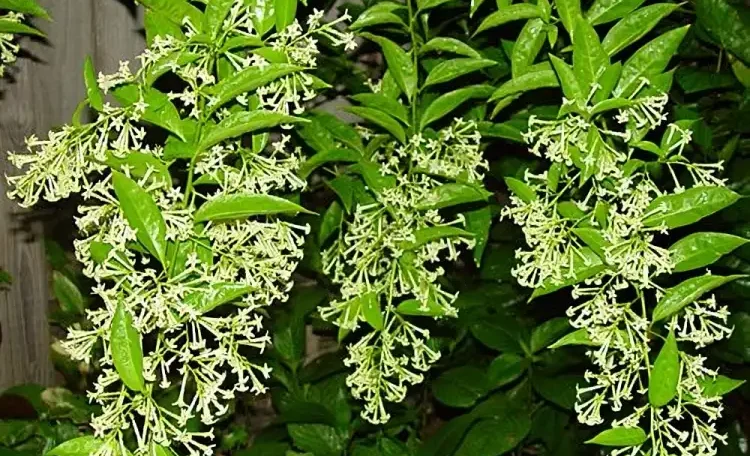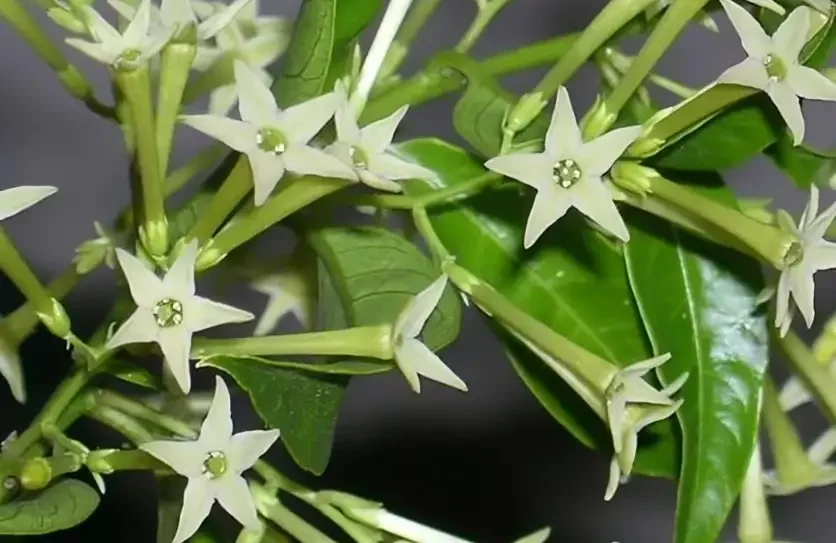The night blooming jasmine plant is a tropical treasure that fills your evenings with intoxicating fragrance and visual charm. Known scientifically as Cestrum nocturnum, this plant transforms gardens into aromatic paradises after sunset. In this detailed care guide, you’ll discover everything about its planting, growing, pruning, and more plus expert tips to make your garden thrive.
Night Blooming Jasmine Plant Overview & Key Features
The night blooming jasmine plant (Cestrum nocturnum) is a tropical evergreen shrub prized for its intense nighttime fragrance and delicate white-green tubular blooms. Unlike most flowering plants that release their scent during the day, this jasmine variety comes alive after sunset filling the air with its sweet, exotic aroma.
Typically growing between 6 to 10 feet tall, it features slender green leaves and clusters of blossoms that open at dusk and close by dawn. Moreover, it’s fast-growing and can be shaped as either a dense shrub or a climbing vine, making it a versatile addition to gardens and patios alike. In addition, its ability to attract nocturnal pollinators such as moths adds ecological value to your landscape. Whether planted near windows, walkways, or outdoor seating areas, the night blooming jasmine plant transforms ordinary evenings into beautifully scented garden experiences.
Why Gardeners Love the Night Jasmine
Gardeners adore this plant because of its captivating fragrance that intensifies at night. Additionally, it attracts pollinators like moths and hummingbirds, enriching your garden’s ecosystem.
Night Blooming Jasmine Plant Growing Conditions

The night blooming jasmine plant thrives best in warm, humid climates where temperatures remain above 60°F (15°C). It prefers well-draining, fertile soil that retains moisture without becoming soggy. For ideal growth, mix organic compost or peat moss into the soil to enhance aeration and nutrient content. This tropical shrub requires full to partial sunlight, receiving at least four to six hours of direct light daily. However, in regions with intense afternoon heat, partial shade helps protect its tender foliage.
Regular watering is essential during the growing season, especially in dry or windy conditions, but allow the topsoil to dry slightly between waterings to prevent root rot. Moreover, maintaining a soil pH between 6.0 and 7.0 ensures optimal nutrient absorption. Because of these adaptable yet specific growing needs, the night blooming jasmine flourishes equally well in containers, raised beds, or open ground offering gardeners flexibility and year-round fragrance.
Best Soil and Light for Night Blooming Jasmine
To ensure success, grow your night blooming jasmine plant in well-draining soil and full to partial sunlight. A mix of compost, peat, and perlite provides ideal conditions. Furthermore, maintain a soil pH between 6.0 and 7.0 to encourage healthy growth.
H3: Watering and Fertilizer Tips for Night Jasmine Care
During its early growth phase, water the night blooming jasmine two to three times weekly. Once established, watering once a week is sufficient. Apply a balanced, slow-release fertilizer twice per year—preferably in spring and midsummer—for optimal blooms.
Pruning and Maintenance
Proper pruning and maintenance are essential to keep the night blooming jasmine plant healthy, attractive, and full of blooms. Pruning should be done right after the flowering season, as this encourages fresh growth and ensures abundant blossoms in the next cycle. Start by removing dead, weak, or diseased branches to improve air circulation and prevent pest infestations. Lightly trimming overgrown shoots also helps maintain a balanced shape, whether you grow it as a compact shrub or train it as a climbing vine.
Additionally, feeding the plant with a balanced fertilizer after pruning supports new leaf and flower development. Always use clean, sharp pruning shears to avoid damaging the stems. Moreover, regular maintenance such as checking for insects, removing spent flowers, and cleaning fallen debris keeps the night blooming jasmine vibrant and long-lasting. With consistent care and attention, this fragrant beauty will reward you with stunning blooms and intoxicating fragrance night after night.
How to Prune Night Blooming Jasmine for Best Results

Prune your night blooming jasmine plant after flowering to control size and encourage bushier growth. Remove dead branches, diseased stems, and old flowers regularly. As a result, you’ll maintain both beauty and vigor throughout the season.
Training Night Jasmine as a Vine or Shrub
This plant can be shaped either as a vine or a compact shrub. For a vine look, support it on trellises or fences. Alternatively, let it branch naturally for a bushier appearance. In cooler regions, consider growing it in containers for easy relocation indoors.
Night Blooming Jasmine Plant Propagation
The night blooming jasmine plant can be propagated easily through stem cuttings or, less commonly, by seeds. Propagation from cuttings is the most reliable method, ensuring that the new plant retains all the desirable traits of the parent. To begin, take a 4–6 inch semi-hardwood cutting from a healthy stem just below a node. Remove the lower leaves and dip the cut end into rooting hormone to speed up root development. Next, plant the cutting in a small pot filled with moist, well-draining soil or a mix of perlite and peat moss.
Cover it loosely with a plastic bag to maintain humidity, and place it in a warm, bright location with indirect sunlight. Within four to six weeks, roots will form, and the cutting will be ready for transplanting. Although the night blooming jasmine can also grow from seeds, this method takes longer and may not produce identical plants. Therefore, most gardeners prefer stem cuttings for faster and more predictable results.
Propagating Night Jasmine from Cuttings
The easiest propagation method is using stem cuttings. Select a semi-hardwood cutting 5–6 inches long, remove lower leaves, and dip it in rooting hormone. Then, plant it in moist soil and cover with a humidity dome. Within a few weeks, roots will develop.
Propagation by Seeds
Although possible, growing night blooming jasmine from seeds takes longer and may not replicate parent traits. If you try it, sow seeds in early spring and keep the soil slightly moist until germination.
Common Night Blooming Jasmine Problems and Solutions
Like many tropical plants, the night blooming jasmine plant can face a few common issues, but most are easily managed with the right care. One of the most frequent problems is yellowing leaves, often caused by overwatering or poor drainage. To fix this, ensure the soil is well-draining and allow the top layer to dry before watering again. Another concern is root rot, which occurs when the roots stay too wet especially in heavy or compacted soil. Moreover, the plant may attract pests such as aphids, mealybugs, or spider mites, which feed on the leaves and sap.
Regularly inspect your jasmine and, if necessary, treat infestations with neem oil or insecticidal soap. Additionally, insufficient sunlight can reduce flowering, so place the night blooming jasmine in a bright spot with at least four hours of sunlight daily. By addressing these issues early and maintaining consistent care, you can keep your jasmine lush, fragrant, and thriving throughout the year.
Pest Issues Affecting Night Jasmine Plants
Common pests include aphids, mealybugs, and spider mites. Manage these with neem oil or insecticidal soap. Additionally, maintain air circulation to prevent fungal infections.
Night Blooming Jasmine Plant Diseases
Root rot may occur due to waterlogging. Ensure proper drainage and avoid heavy clay soil. Yellow leaves often indicate nutrient deficiency—feed with a balanced micronutrient solution.
Benefits & Uses
The night blooming jasmine plant offers a beautiful blend of aesthetic appeal, soothing fragrance, and practical benefits for both home and garden. Its intoxicating nighttime scent makes it a popular choice for patios, balconies, and walkways adding an inviting ambiance to outdoor spaces. Beyond its ornamental value, the plant also attracts nocturnal pollinators like moths, contributing to a balanced and biodiverse garden ecosystem.
Moreover, the fragrance of night blooming jasmine is known for its calming and stress-relieving properties, making it ideal for relaxation areas or meditation gardens. Many gardeners also use it as a natural air freshener, placing potted jasmine near windows or doors to let the sweet aroma drift indoors at night. In addition, its fast growth and dense foliage make it suitable for use as a privacy hedge or decorative screen. Whether you grow it for beauty, fragrance, or tranquility, this enchanting plant enhances every space it graces.
Night Jasmine Fragrance and Garden Beauty
The night blooming jasmine plant is ideal for patios, walkways, and windows where its fragrance can be enjoyed after sunset. Pair it with other night bloomers such as moonflower or evening primrose for maximum effect.
Health and Relaxation Benefits of Night Blooming Jasmine
This plant’s scent has been linked to relaxation and stress relief. Moreover, its nocturnal aroma promotes a peaceful atmosphere, making it perfect for evening meditation or outdoor dining spaces.
Night Blooming Jasmine Plant Seasonal Care

Proper seasonal care for the night blooming jasmine plant ensures continuous growth, lush foliage, and an abundance of fragrant blossoms throughout the year. This tropical beauty thrives in warm temperatures but requires special attention during seasonal transitions. In spring, prune lightly and feed with a balanced fertilizer to encourage new growth. During summer, maintain consistent watering and provide partial shade during extremely hot afternoons to prevent leaf scorch.
As autumn approaches, reduce watering gradually and remove faded blooms to prepare the plant for dormancy. In winter, protect your night blooming jasmine from frost by moving potted plants indoors or covering outdoor ones with frost cloths. Keeping it in a warm, bright location helps sustain healthy roots and prevent stress. By adjusting your care routine with the changing seasons, your night blooming jasmine plant will reward you with mesmerizing nighttime fragrance and vibrant blooms year after year.
Winter Protection for Night Jasmine
Since the night-blooming jasmine is frost-sensitive, protect it during cold months. Move potted plants indoors or use frost cloths outdoors. In addition, trim lightly before winter to reduce stress. For more creative indoor plant ideas, you can explore this guide on terrariums with lights to enhance your indoor gardening setup.
Summer Bloom Enhancement Tips
During summer, provide adequate sunlight and avoid overwatering. Feeding with a phosphorus-rich fertilizer encourages abundant blooms.
FAQs
When Does the Night Blooming Jasmine Plant Bloom?
It blooms mainly from spring through fall, with flowers opening at night and closing at dawn.
Is Night Blooming Jasmine Toxic to Pets?
Yes, all parts of the night blooming jasmine plant are mildly toxic if ingested. Therefore, keep it away from pets and children.
How Can I Enhance the Fragrance of Night Blooming Jasmine?
To intensify its fragrance, prune regularly, avoid over-fertilizing, and ensure it receives plenty of sunlight throughout the day.
Can Night Blooming Jasmine Grow Indoors?
Yes, the night blooming jasmine plant can grow indoors in bright light and warm conditions. Use a large pot with good drainage to prevent waterlogging.
Conclusion
In conclusion, the night-blooming jasmine plant is one of the most enchanting and aromatic additions to any home garden. With the right soil, sunlight, and care, it rewards you with sweet-scented nights and tropical beauty. Whether grown outdoors or indoors, its charm is undeniable. For an elegant way to display your jasmine or other trailing plants, consider using a stylish macrame hanging planter to enhance your home decor and create a beautiful vertical garden effect.


















